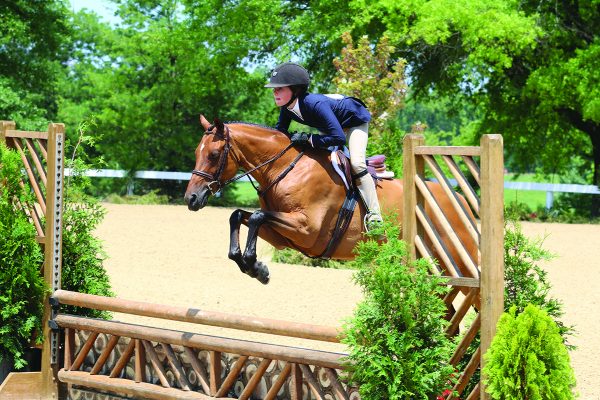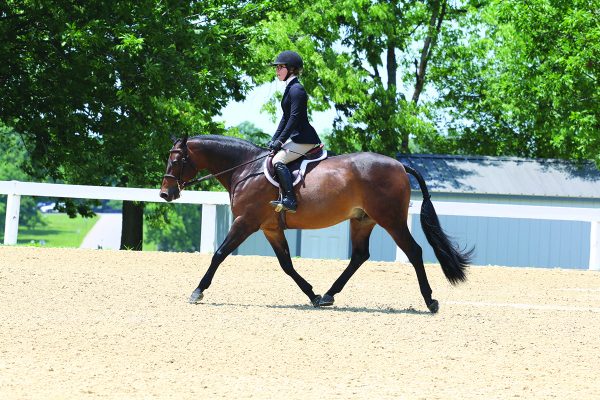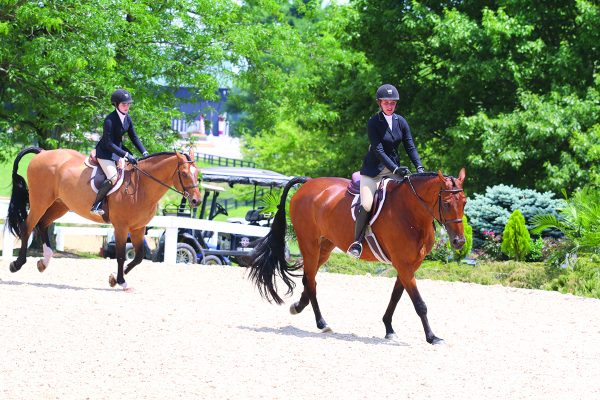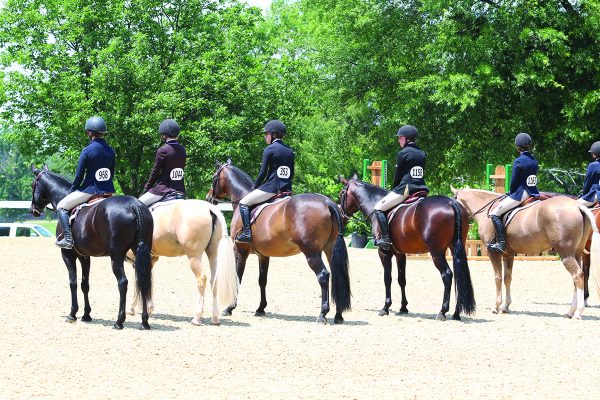Hunter hack is where an all-around English riding horse can really shine. This popular class is divided into two parts: flatwork and jumping. Hunter hack celebrates the horse that is safe to ride as a hunter and also as a hack, which is another term for an English pleasure horse.

Which Comes First in Hunter Hack?
The format of hunter hack can vary, depending on where you’re showing. Breed shows often start with jumping. Each horse enters the ring, one at a time, and jumps the short course. Then all the horses work together as a group on the flat.
At hunter shows, however, the flatwork comes first. Once that’s finished, the entire class lines up in the center of the arena. Then each competitor takes a turn jumping. Regardless of the order, hunter hack classes are essentially judged the same.
Flatwork Finesse
For the flatwork portion of hunter hack, all of the entries perform as a group at the walk, trot and canter in traditional rail-class fashion. The judge is looking for horses that are suitable to ride across the open countryside.

The best hunter hack horses are good “long and low” movers that appear comfortable to ride. They should also display nice manners and remain relaxed and pleasant, even if crowded by other horses. Hunter hack winners are also obedient and execute smooth transitions from one gait to the next.
If you ride in a hunter hack class, keep light contact on the reins and encourage your horse to move forward with some energy. Your horse should look happy to do his job. You should try to give the impression that you’re having a good time, too. You don’t need to smile, which can look fake, but make sure to ride with confidence.
Remember that the judge can spot an expression of fear or frustration, especially as you pass the judge’s booth. Try to give the impression that your horse is the most enjoyable one to ride in the class.
Just a Few Jumps
Horses in hunter hack are required to jump two or three low fences. This proves that they can be trusted to safely jump low obstacles commonly found on a trail. These jumps are usually set in a line with a certain number of cantering strides between each one.

When competing in hunter hack, be sure to watch the riders who jump through the line before you. Count the number of strides from one jump to the next. That way you’ll have a plan. You’ll be able to ride through the line smoothly, and not be surprised when your horse leaves the ground to jump. That’s important, because any bobbles or awkward jumping will be penalized.
Also, keep your eyes up and stay focused on riding a straight line. Zig-zagging between the jumps makes your horse look like he’s hesitating. Finally, keep riding all the way through the line at a steady pace. If your horse refuses a jump, it will probably drop you out of the ribbons.
All the Extras
Somewhere during the class, you’ll be asked to perform a few other tests. The judge often wants to see your horse hand-gallop, halt and back up for several steps. Each of these tests are important. Listen carefully to the announcer, who will explain exactly what the judge wants to see.
Don’t be confused by the hand gallop. While it isn’t a flat-out run, it’s definitely more than just a fast canter. During the hand gallop, your horse should clearly lengthen his stride, and you should adjust your position to a half-seat or two-point.

When it comes time to halt, plan ahead. Apply your aids several strides before you actually need to stop so your horse doesn’t resist and remains straight. Wait several seconds before backing or returning to the line-up—whichever the judge requested—to demonstrate your horse’s good manners.
Once you line up, stay focused. Although the judge may be watching the other riders, you’ll become the center of attention if your horse misbehaves or wanders out of the line. Don’t let all of your hard work go to waste at the last moment.
Hunter Hack Judging Notes
In hunter hack, the flatwork and the jumping count about equally. The judge can’t determine the ribbons until both portions of the class are finished. Hunter hack is rarely a dull class because the ribbon placings may be juggled several times.
For example, a horse that is impressive on the flat may refuse the jumps. Suddenly, the horse that seemed destined to win the blue ribbon is eliminated entirely. On the other hand, a horse that wasn’t spectacular on the flat may jump in excellent style, and flawlessly execute the hand gallop and halt. As a result, that horse earns a spot near the top of the ribbons. That’s why it’s important to keep doing your best until you’re certain that the entire class is completed.
This article about the hunter hack class appeared in the Spring 2021 issue of Young Rider magazine. Click here to subscribe!


